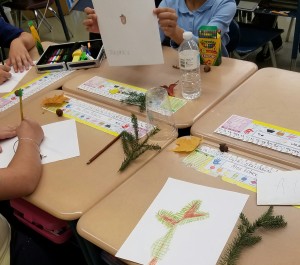Autumn is a great time to explore our senses, and to build sensory vocabulary in the classroom. Using leaves and branches and acorns gathered from outside, the goal with the students this week was to understand how close scientific observation leads to good writing. I wanted to move them through sensory vocabulary, scientific observation, and poetic observation.
I handed out pine tree branches as we sat together on the rug. “Ouch!” they yelled as they eagerly grabbed them. “Pointy!” “Sharp!” I wrote these words on chart paper, and asked them what else they could tell me about the branches. “Green.” “Prickly.” I asked them to smell them. “Minty!” “Sweet.” I continued asking them to use various senses to describe the branches, writing get their words on the chart paper. “These are Sensory Words,” I explained as I wrote the title of our list. “They catch people’s attention if you use them when you write.”
Next I had them bring the branches to their seats, also passing out maple leaves and acorns. I asked them to draw “like a scientist,” one of the three items, with as much detail as they could. My goal was to move them through three stages of observation and writing:
- List sensory vocabulary (texture, color, smell, shape, etc)
- Specific observations
- Poetic/abstract thinking
In the above drawing of an acorn, you can see that the student moved through these three stages. She used sensory vocabulary (“bumpy,” “fresh,” “smooth”) and then went on to make scientific observations (“I noticed tiny lines,” etc.. From there, she moved into a more abstract comparison (“This acorn reminds me of a marshmallow wearing a hat”). This is a great time to assess their vocabulary, and to encourage them to share words and ideas with each other.
Inevitably, the kids were chatting about what their drawings looked like. “Mine kind of looks like a cactus,” one said about his branch drawing. “This looks like a fly swatter!” a girl who had drawn a leaf said. I decided it was a window to talk about metaphors. I asked them to all wrote a sentence on their papers, describing what it looks like other than what it really is. Although we did not define metaphors in the true sense (i.e. “the leaf is like a ____”), they were beginning to think metaphorically as they made their comparisons and shared their ideas.

The students agreed that scientists make good writers. For me, the child who drew and wrote about the above leaf, comparing it to a “bat with smooth wings,” demonstrates the power of close observation.

